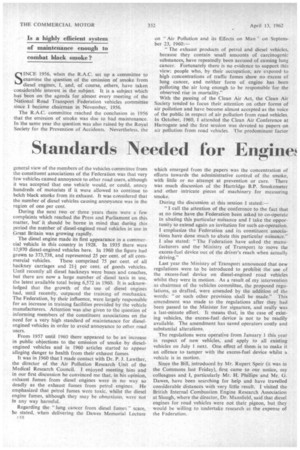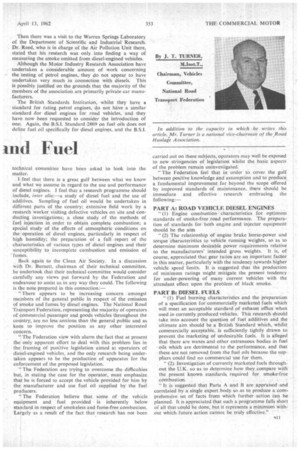Standards Needed for Engine Ind Fuel
Page 44

Page 45

If you've noticed an error in this article please click here to report it so we can fix it.
general view of the members of the vehicles committee from the constituent associations of the Federation was that very few vehicles caused annoyance to other road users, although it was accepted that one vehicle would, or could, annoy hundreds of motorists if it were allowed to continue to belch black smoke from its exhaust. It was considered that the number of diesel vehicles causing annoyance was in the region of one per cent.
During the next two or three years there were a few complaints which reached the Press and Parliament on this matter, but it should be borne in mind that during this period the number of diesel-engined road vehicles in use in Great Britain was growing rapidly.
The diesel engine made its first appearance in a commercial vehicle in this country in 1928. In 1935 there were 10,970 diesel-engined vehicles here. In 1960 the figure had grown to 373,738, and represented 25 per cent. of all com mercial vehicles. These comprised 75 per cent, of all hackney carriages and 211 per cent. of goods vehicles. Until recently all diesel hackneys were buses and coaches, but there are now a large number of diesel taxis in use, the latest available total being 6,572 in 1960. It is acknowledged that the growth of the use of diesel engines had, until recently, outpaced the training of mechanics. The Federation, by their influence, were largely responsible for an increase in training facilities provided by the vehicle manufacturers. Attention was also given to the question of informing members of the constituent associations on the need for a very high standard of maintenance for dieselerigined vehicles in order to avoid annoyance to other road users.
From 1957 until 1960 there appeared to be an increase in public objections to the emission of smoke by dieselengined vehicles and in 1960 articles started to appear alleging danger to health from their exhaust fumes.
It was in 1960 that I made contact with Dr. P. J. Lawther, the director of the Air Pollution Research Unit of the Medical Research Council. I enjoyed meeting him and in our first discussion he convinced me that, in his opinion, exhaust fumes from diesel engines were in no way so deadly as the exhaust fumes from petrol engines. He emphasized that petrol fumes were toxic, whilst the diesel engine fumes, although they may be obnoxious, were not in any way harmful.
Regarding the "lung cancer from diesel fumes" scare, he stated, when delivering the Dawes Memorial Lecture r10 which emerged from the papers was the concentration of efforts towards the administrative control of the smoke, with little or no attempt at prevention or cure. There was much discussion of the Hartridge B.P. Smokemeter and other intricate pieces of machinery for measuring smoke.
During the discussion at this session I stated:— "I call the attention of the conference to the fact that at no time have the Federation been asked to co-operate in abating this particular nuisance and I take the opportunity to extend again an invitation for such co-operation. I emphasize the Federation and its constituent associations have done much to abate this particular nuisance." I also stated: "The Federation have asked the manufacturers and the Ministry of Transport to move the excess-fuel device out of the driver's reach when actually driving."
Last year the Ministry of Transport announced that new regulations were to be introduced to prohibit the use of the excess-fuel device on diesel-engined road vehicles whilst they were in motion. As a result of my intervention as chairman of the vehicles committee, the proposed regulations, as drafted, were amended by the addition of the words: "or such other provision shall be made." This amendment was made to the regulations after they had been passed to the Minister for signature, and really was a last-minute effort. It means that, in the case of existing vehicles, the excess-fuel device is not to be readily available. The amendment has saved operators costly and substantial alterations.
The regulations were operative from January 1 this year in respect of new vehicles, and apply to all existing vehicles on July 1 next. One effect of them is to make it an offence to tamper with the excess-fuel device whilst a vehicle is in motion.
Since the Bill, introduced by Mr. Rupert Speir (it was in the Commons last Friday), first came to our notice, my colleagues and I, particularly Mr. H. Phillips and Mr. G. Dawes, have been searching for help and have travelled considerable distances with very little result. I visited the British Internal Combustion Engine Research Association at Slough, where the director, Dr. Mansfield, said that diesel engines for road vehicles were not their pigeon, but they would be willing to undertake research at the expense of the Federation.
technical committee have been asked to look into the matter.
I feel that there is a great gulf between what we know and what we assume in regard to the use and performance of diesel engines. I feel that a research programme should include, inter alia:—a study of diesel fuel and the use of additives. Sampling of fuel oil would be undertaken in different parts of the country; extensive field work by a research worker visiting defective vehicles on site and conducting investigations; a close study of the methods of fuel injection in order to obtain complete combustion; a special study of the effects of atmospheric conditions on the operation of diesel engines, particularly in respect of high humidity; the preparation of a full report of the characteristics of various types of diesel engines and their susceptibility to incomplete combustion and emission of fumes.
Back again to the Clean Air Society. In a discussion with Dr. Burnett, chairman of their technical committee, he undertook that their technical committee would consider carefully any views put forward by the Federation and endeavour to assist us in any way they could. The following is the note prepared in this connection:— " There appears to be• increasing concern amongst members of the general public in respect of the emission of smoke and fumes by diesel engines. The National Road Transport Federation, representing the majority of operators of commercial passenger and goods vehicles throughout the country, are no less anxious than the general public and as keen to improve the position as any other interested concern.
"The Federation view with alarm the fact that at present the only apparent effort to deal with this problem lies in the framing of punitive legislation aimed at operators of diesel-engined vehicles, and the only research being undertaken appears to be the production of apparatus for the enforcement of the proposed legislation.
"The Federation are trying to overcome the difficulties but, in stating the case for the operator, must emphasize. that he is forced to accept the vehicle provided for him by the manufacturer and use fuel oil supplied by the fuel producers.
"The Federation believe that some of the vehicle equipment and fuel provided is inherently below standard in respect of smokeless and fume-free combustion. Largely as a result of the fact that research has not been carried out on these subjects, operators May well be exposed to new stringencies of legislation Whilst the basic aspects of the problem remain uninvestigated: •
"The Federation feel that in order' to. cover the gulf between positive knowledge and assumption and to produce a fundamental improvement far beyond the scope offered by improved standards of maintenance, there should be immediate and effective research embracing the following:— PART A: ROAD VEHICLE DIESEL ENGINES
" (1) Engine combustion characteristics for optimum standards of smoke-free road performance. The preparation of standards for both engine and injector equipment should be the aim "(2) The relationship of engine brake horse-power and torque characteristics to vehicle running weights, so as to determine minimum desirable power requirements relative to the manufacturers' intended gross weights. It is, of course, appreciated that gear ratios are an important factor in this matter, particularly with the tendency towards higher vehicle speed limits. It is suggested that the production of minimum ratings might mitigate the present tendency for under-powering of many current vehicles with the attendant effect upon the problem of black smoke.
PART B: DIESEL FUELS.
" (1) Fuel burning characteristics and the preparation of a specification for 'commercially marketed fuels which will meet an acceptable standard of exhaust efflux when used in currently produced vehicles. This research should take into account the question of fuel additives and the ultimate aim should be a British Standard which, whilst commercially acceptable. is sufficiently tightly drawn to prevent the marketing of undesirable fuels, it is alleged
• that there are waxes and other extraneous bodies in fuel 'oils which are detrimental to the performance, and that these are not removed from the fuel oils because the sup pliers could find no commercial use for them. .
" (2) Investigation of currently marketed fuels through, out the U.K. so as to determine how they ,compare with the ,present known standards, required for sinoke-free combustion. .
• "It is suggested that Parts A and B are appraised and correlated by a single expert bodyso,as to produce a comprehensive set of facts from which further action can he planned. It is appreciated that such a programme falls short of all that could be done, but it-represents a•minimiim without which future action cannot be truly effective."




















































































































